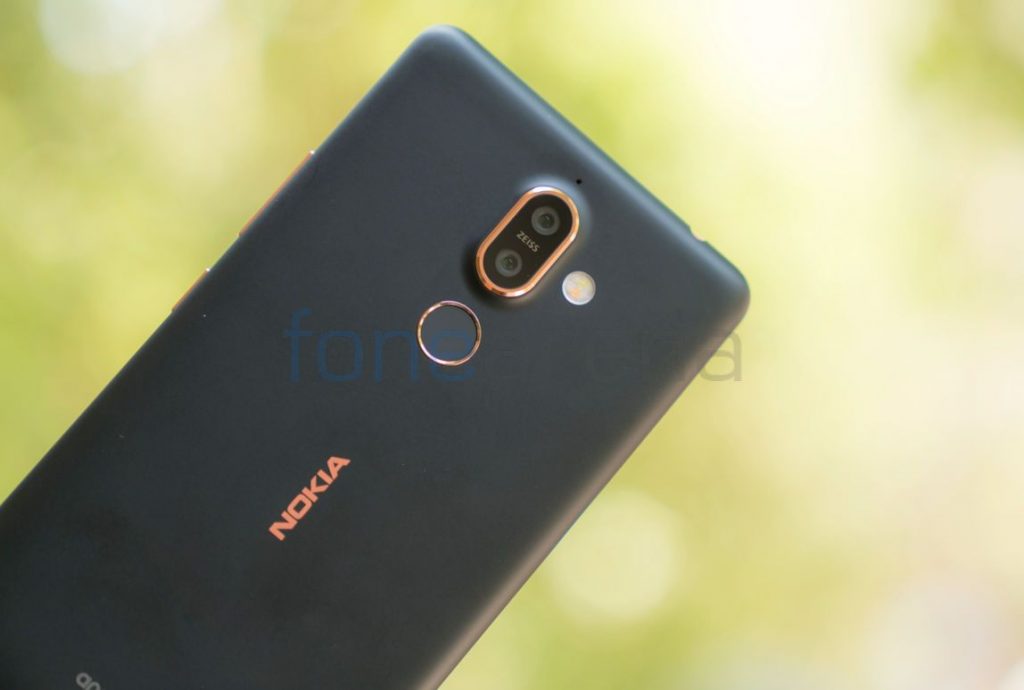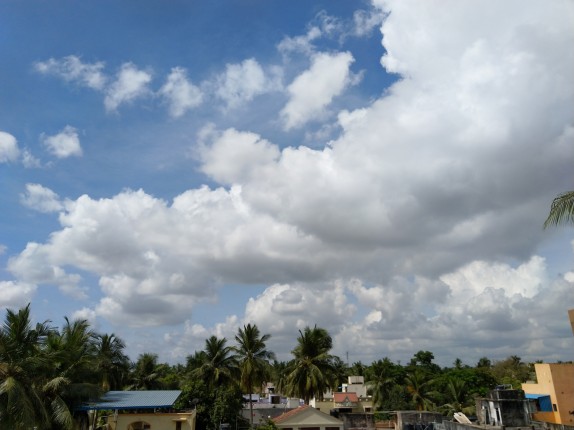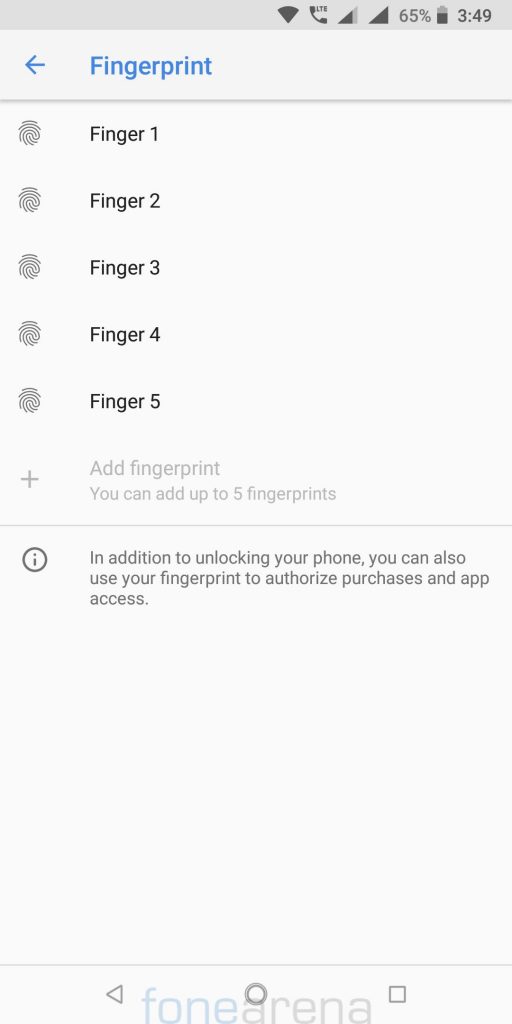
HMD Global launched the Nokia 7 Plus along with a range of smartphones in its Android One line-up in India earlier this month. This is the company’s first smartphones with 18:9 aspect ratio display. It has a powerful Snapdragon 660 SoC, comes with stock Android 8.1 (Oreo) and also features dual rear cameras. The specifications of the phone looks good on paper. Is it worth the price? Let us find out in the complete review.
Unboxing
We recently unboxed the phone, check out the video below.
Box Contents

- Nokia 7 Plus smartphone in Black / Copper color
- 2-pin fast charger (5V-2.5A/9V-2A/12V-1.5A)
- USB Type-C Cable
- In-ear headset
- SIM Ejector tool
- Clear protective case
- User manual and warranty information
Display, Hardware and Design

The Nokia 7 Plus packs a large 6-inch display with a pixel resolution of 2160 by 1080 pixels, pixel density of 402 PPI and an aspect ratio of 18:9. The display is bright, has good viewing angles and the sunlight legibility is good as well. It also has Corning Gorilla glass 3 protection.
It has ambient display option in the settings that shows notification on the lock screen when you lift the phone and it can also wake up to screen when you receive notifications. It also has Night light that tints the screen amber so that you can see or read in dim light, and may help you fall asleep more easily.

Since this has a 18:9 aspect ratio screen, you can pinch to zoom to fill the screen when you use apps like YouTube, but the content is cropped. Several apps support full-screen, but JioTV or Airtel Live TV apps don’t support full-screen, so you get weird black bars.

On the top there is an earpiece, 16-megapixel camera along with Nokia branding. It also has the usual set of proximity and ambient light sensors. It has gyroscope and magnetic sensor otherwise known as magnetometer for VR headsets. It doesn’t have notification LED, and the ambient display compensates for this.

Even though the phone has on-screen buttons, there is a small bezel below the display.
The volume rockers and the power button are present on the right side, hybrid dual SIM slot is present on the left, 3.5mm audio jack is present on the top, and the primary microphone, USB Type-C port and the loudspeaker grill are present on the bottom.

There is a 12-megapixel primary rear camera along with a 13-megapixel secondary camera with ZEISS optics, dual-tone LED flash. The secondary microphone is present above the camera module and the fingerprint sensor is present below it. There is also Nokia branding. Since this has a hybrid dual SIM slot, it accepts two nano SIMs or a nano SIM and a microSD that accepts cards up to 256GB.

The phone has smooth matte finish on the back, which attracts fingerprints easily, but it doesn’t slip out of your hands. It has 6000 series aluminium frame that offers a solid feel when you are holding it. Overall the build quality is good. The phone also comes in White with Copper color.

You can use the bundled case to prevent smudges. It measures 158.38 x 75.64 x 9.55 mm and weighs 183 grams, mainly due to the metal body. Even though the phone has an 18:9 aspect ratio display, it has about 77% screen-to-body ratio, almost same as the Xiaomi Redmi Note 5 Pro.
Camera

The Nokia 7 Plus packs a 12-megapixel primary rear camera with f/1.75 aperture, 1.4µm pixel size with ZEISS optics, dual-tone LED flash along with a 13-megapixel secondary camera with telephoto lens, 1.0µm pixel size, f/2.6 aperture with ZEISS optics to capture the depth information for portrait shots and also offers 2X loss-less zoom. It also has a 16-megapixel camera on the front with f/2.0 aperture and ZEISS optics.
The Camera UI is simple with toggles for front or rear camera, flash, HDR, Timer, PIP or Dual capture mode and settings on the left. There is also Panorama, Pro mode (to adjust white balance, focus, ISO, shutter speed and exposure compensation) and Live Bokeh.
Coming to the image quality, daylight shots came out well and the HDR shots were better. Macro shots were good as well. 2x loss-less zoom is useful when you want to get close-up shots. Since this has a telephoto secondary lens, you can’t capture close-up bokeh images using dual cameras, and it says you are too close. You also get a warning when the condition is too dark when you capture bokeh images. It detects people clearly compared to objects and sometimes it is hard to focus. Low-light images are decent, and there isn’t much noise, but images are underexpose a little. Pro mode offers better results in low-lighting conditions. Images with flash are decent and the flash is not overpowering. Thanks to dual-tone flash, it helps to maintain skin tone, but some images have a yellowish tint. Front camera is good for selfies, but the portrait selfie is not perfect since it blurs out things like hair.
Check out the camera samples (Click the image to view full-resolution sample).







It can record videos at maximum 4K resolution at 30 fps. It doesn’t have OIS, but has auto EIS, which works only in 1080p mode, which is good. It doesn’t support 1080p 60 fps recording, which is a bit disappointing. There is also slow-motion recording at 1080p resolution. Since it has three microphones and supports Nokia OZO Audio, audio is crisp. Check out the video samples below.
Check out the complete set of Nokia 7 Plus Camera Samples here.
Software, UI and Apps
Coming to the software, the phone runs on stock Android 8.1 (Oreo) with Android security update for April 1st, 2018. It also has Treble support and support for A/B System Partition for seamless updates. At the launch the company promised to offer latest Android security updates every month and also update to upcoming Android P. This is a great move from HMD Global.
It has all the Android 8.1 features including Picture-in-Picture (PIP), Auto fill, New Settings Menu, Bluetooth Battery percentage, revamped power menu and new settings menu. It also has support for gestures that lets you turn over to reject call, mute the phone on pickup, swipe fingerprint sensor for notifications, quick open the camera by pressing the power button twice even when the phone is locked and lift the phone to check time, notification and other info. These gestures can be enabled from the “System” in the settings. Since the phone runs on stock Android, there is nothing to specify about the software.
Out of 4GB LPDDR4 RAM, 3.72GB of RAM is usable, out of which 2.7GB of RAM is free when default apps are running in the background. Out of 64GB of storage (eMMC 5.1), about 50.49GB is free out of the box. Apart from the usual set of utility apps and Google apps, the phone doesn’t have any other bloatware.
Fingerprint Sensor
The fingerprint sensor is present on the back and is easy to access. It is quick to unlock the phone most of the times as soon as you place your finger on the sensor. It unlocks the phone even when the screen is off, so you don’t need to unlock the phone for the fingerprint recognition to work. You can add up to 5 fingerprints and you can also use your fingerprint to authorize Google Play purchases. At the launch the company said that all the three Android One smartphones have Face unlock, but our unit doesn’t have Face unlock feature yet. The feature will be added through an over-the-air (OTA) update soon.
Music Player
Google Play Music is the default music player. It also has equalizer, bass boost and also lets you enable surround sound when you insert earphones. The speaker is present on the bottom part of the phone and is quite loud even in noisy environment. Audio doesn’t get muffled when the phone is placed on a flat surface since it is on the bottom. Audio quality is good through the bundled headset. It can play 1080p Full HD videos smoothly. The phone doesn’t have FM Radio.
Connectivity, Calling and Messaging
It has 4G connectivity with support for 4G VoLTE for Reliance Jio and Airtel. Both the SIM slots have 4G support, but you can use 4G on only one SIM at a time and other goes to 3G as well as 4G VoLTE support. Other connectivity features include, WiFi 802.11 WiFi 802.11 ac (2.4GHz + 5GHz), Bluetooth 5, GPS, NFC and USB Type-C.
Since this is a dual SIM phone you get option to call or send SMS from either SIMs. It comes with Gbroad as the default keyboard. We did not face any call drops or any other issues.
Performance and Benchmarks

It is powered by an Octa-Core Qualcomm Snapdragon 660 64-bit 14nm Mobile Platform that has four Kryo 260 CPUs clocked at 2.2GHz per core and other four Kryo 260 CPUs are clocked at 1.8GHz per core. The performance is good. We tested several games, which were smooth and graphics is good as well, thanks to the Adreno 512 GPU. 4GB of RAM is enough for multitasking and run several apps in the background. Still, the company could have gone with 6GB RAM for the phone, which is a trend these days even in mid-range smartphones. The phone doesn’t get hot when using 4G or playing games for long time.
It tops in all the benchmarks. Check out some synthetic benchmark scores below.




Battery life

The phone packs a 3800mAh battery, which lasts for more than a day on a single charge with average use and whole day even with heavy use. It warns when an app is consuming more battery so you can close it. You can enable battery saver to extend the battery life when the battery hits a certain threshold.

It achieved a One Charge Rating of 16 hours and 51 minutes in our battery test, mainly due to brilliant talk time, but this is good for a phone with a 3800mAh battery and a huge 6-inch screen. Since the phone has support for fast charging, it takes just 37 minutes to charge from 0 to 50% and 1 hour and 44 minutes to charge from 0 to 100%. We will bring you the complete set of battery life test results soon.
Conclusion
Overall, the Nokia 7 Plus is a solid package with a large 6-inch 18:9 aspect ratio display, powerful Snapdragon 660 SoC, good cameras, stock Android Oreo with support for Treble as well as A/B seamless updates, all in a solid metal body. However, the Rs. 25,999, is a bit high considering the Nokia 8 costs just a bit more after a recent price cut offering better overall specifications and a water-resistant body. May be the company could have priced it cheaper if they had gone with online-only route.
The phone is available for order from Nokia mobile shop and offline stores like Sangeetha, Poorvika, Big C, Croma and Reliance. It goes on sale from April 30th online and offline, including Amazon.in. To summarize, here are the pros and cons of the smartphone.
Pros
- Solid build quality
- Large 6-inch 18:9 screen
- Good cameras
- Good performance
- Stock Android Oreo with Treble, A/B seamless updates
Cons
- Priced slightly on the higher side
- Hybrid Dual SIM might not be preferred by everyone
- No notification LED



























